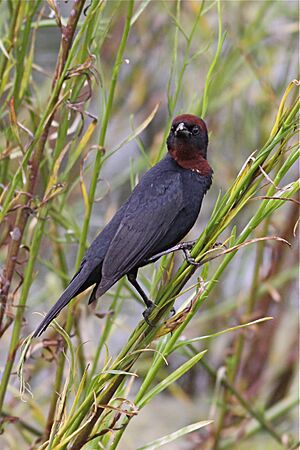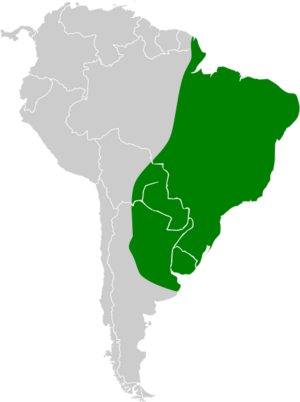Chestnut-capped blackbird facts for kids
Quick facts for kids Chestnut-capped blackbird |
|
|---|---|
 |
|
| Male | |
| Conservation status | |
| Scientific classification | |
| Genus: |
Chrysomus
|
| Species: |
ruficapillus
|
 |
|
| C. ruficapillus distribution | |
| Synonyms | |
|
Agelaius ruficapillus Vieillot, 1819 |
|
The Chestnut-capped Blackbird (scientific name: Chrysomus ruficapillus) is a type of bird that belongs to the Icteridae family. You can find these birds in several South American countries, including Argentina, Bolivia, Brazil, French Guiana, Paraguay, and Uruguay. They love living in wet places like swamps, rice fields, and grassy areas. Experts at the International Union for Conservation of Nature say this bird is a "least concern" species, which means it's not currently in danger.
Contents
About the Chestnut-capped Blackbird
The Chestnut-capped Blackbird looks different depending on if it's a male or a female. This is called sexual dimorphism. Both male and female birds have a straight, dark beak with a sharp tip. They also have dark legs.
Male Birds
Male Chestnut-capped Blackbirds are mostly shiny black. Their head and throat are a bright chestnut (reddish-brown) color. Birds living in the southern parts of their home range tend to have darker heads than those in the north.
Female Birds
Female Chestnut-capped Blackbirds look different from the males. Their upper body is a dark olive-brown color. They have some faint black streaks on their back. Their belly and chest are a lighter olive-brown. The streaking on their back is not as clear as on other birds in the same group.
Bird Calls
These birds make many different sounds. Their calls include various trills and whistles. Their song is a long sound that goes "chree-chree-churrr."
Where They Live
The Chestnut-capped Blackbird lives in the tropical and semi-tropical eastern parts of South America. They can be found in areas up to about 850 metres (2,800 ft) high. Their home range covers a large part of the Amazon Basin. It stretches from northern Brazil all the way down to northern Argentina. These birds are usually found near water, like in marshes, nearby grasslands, and rice fields.
Conservation Status
The total number of Chestnut-capped Blackbirds is not known exactly. However, their population seems to be stable. This bird lives across a very large area and is often seen. Because of this, the International Union for Conservation of Nature has decided that its conservation status is "least concern." This means they are not worried about this species becoming endangered anytime soon.


